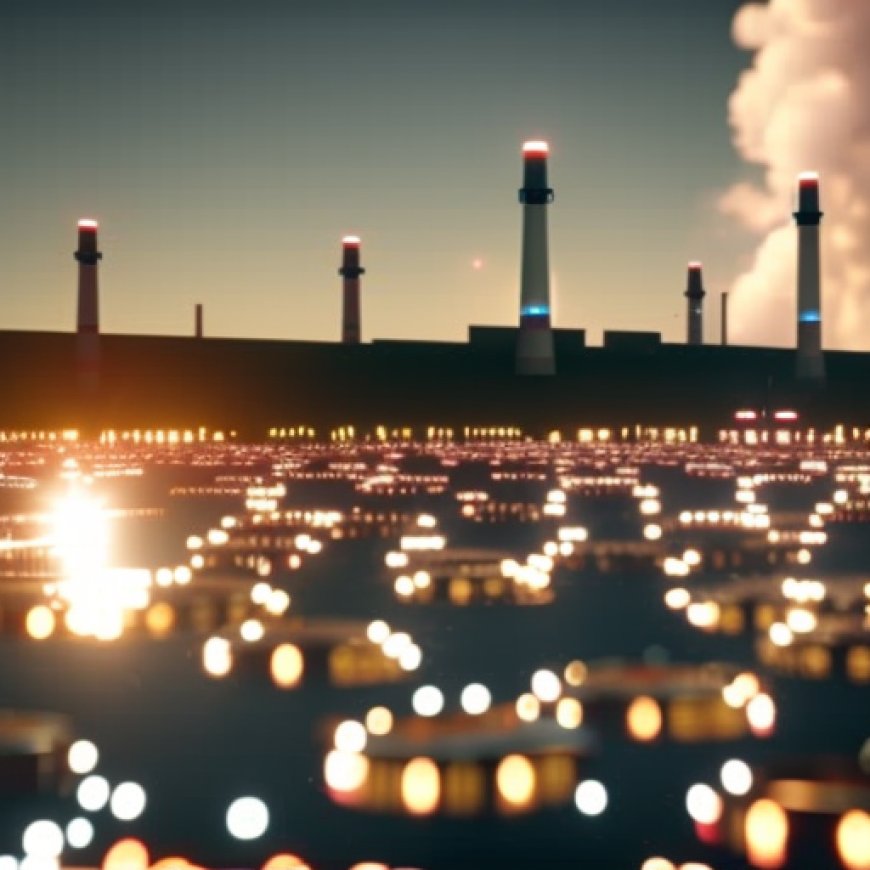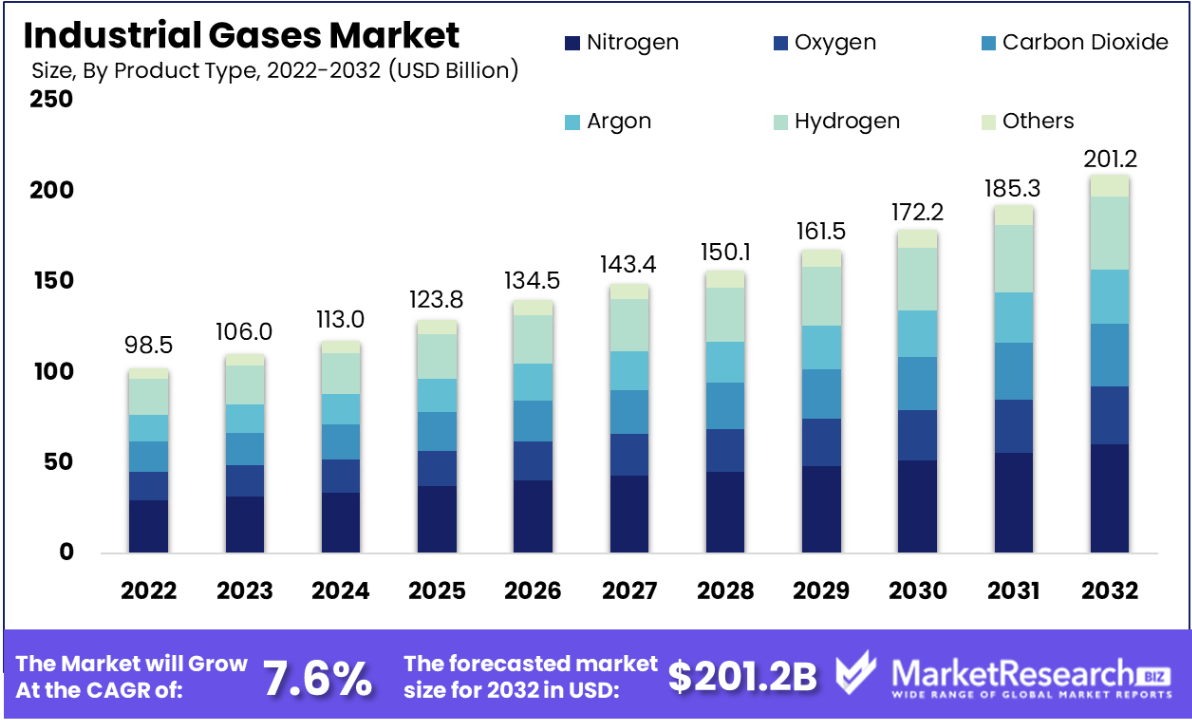Industrial Gases Market to Reach US$ 201.2 Billion by 2032, Poised for 7.6% CAGR in the Forecast Period
Industrial Gases Market to Reach US$ 201.2 Billion by 2032, Poised ... GlobeNewswire


New York, Oct. 12, 2023 (GLOBE NEWSWIRE) — Industrial Gases Market Achieves USD 98.5 Billion Valuation in 2022, Forecasted to Reach USD 201.2 Billion by 2032
The global industrial gases market achieved a valuation of USD 98.5 billion in 2022, with a forecasted compound annual growth rate (CAGR) of 7.6% from 2023 to 2032. The market aims to reach USD 201.2 billion by 2032, driven by various growth factors and the demand from industries such as pharmaceuticals, electronics, food and beverage, and others.
Key Growth Areas
- The pharmaceutical and electronic industries are emerging as key drivers of demand in the industrial gases market.
- The food and beverage industry is also a significant consumer of industrial gases.
- Industrial gases play a crucial role in numerous production processes.

Industrial Gases Market Overview
The industrial gases market is a dynamic sector with significant potential for development and growth. Gases such as nitrogen, oxygen, argon, carbon dioxide, and hydrogen are essential in various industries, including food, healthcare, electronics, and energy. The market is driven by innovation, with a focus on sustainable solutions like green hydrogen and specialty gases for high-tech applications.
In October 2023, the United States Environmental Protection Agency (EPA) introduced new measures targeting climate-warming industrial gases, specifically hydroflourocarbons (HFCs). These regulations are expected to have a significant impact on the industrial gases market, driving the demand for eco-friendly alternatives and fostering global awareness of the environmental impact of industrial gases.
Atlas Copco’s acquisition of medical gas system specialists in October 2023 indicates growing demand for specialized industrial gas services, particularly in healthcare. This expansion into specialized services could open new growth opportunities within the industrial gases market.
Advanced storage solutions and sustainability efforts, such as carbon capture and utilization (CCU), are enhancing safety, efficiency, and environmental performance in the industrial gases industry. The Asia Pacific region is experiencing significant growth in the market due to its robust economy and industrialization.
Key Takeaways
- The industrial gases market is expanding due to high demand in sectors such as healthcare, metalworking, construction, and aerospace.
- The oil and gas sector is a key driver of industrial gas demand, particularly in critical operations like refining, separation, and pipeline management.
- Nitrogen is a prominent industrial gas due to its cost-effectiveness, safety, and versatility.
- The manufacturing industry leads in the use of industrial gases for processes such as welding, cutting, heat treatment, and electronics manufacturing.
- Packaged industrial gases dominate the market, offering flexibility across diverse industries.
- The Asia Pacific region holds a dominant position in the industrial gases market, driven by its expanding economy and rapid industrialization.
Driving Factors
Growth in the food and beverage (F&B) Industry
The industrial gases market is expanding significantly in the food and beverage sector. These gases are essential for maintaining the quality of goods, improving the sensory experience of carbonated drinks, and preserving food freshness. The increase in the use of packaged foods and changes in consumer lifestyles are driving this growth.
Demand from the Oil & Gas Industry
The oil and gas industry consumes a significant amount of industrial gases, especially for operations like refining and separation. The anticipated rise in global oil consumption is expected to drive the demand for gases like nitrogen and argon. India’s large refining capacity further supports this sector.
Restraining Factor
High Capital Expenditure
The establishment of production and distribution plants requires a significant capital investment. The infrastructure for industrial gas generation, storage, and transportation is costly to create and maintain. This high capital expenditure acts as a barrier to entry for smaller businesses and restricts market expansion.
Growth Opportunities
Development of the healthcare industry
The healthcare industry has a growing demand for medical gases, especially after the COVID-19 pandemic. The increasing need for medical oxygen and other specialty gases presents growth opportunities for industrial gas suppliers, particularly in developing countries.
Modernization and Quickly Developing Technology
Technological advancements have led to the development of new industrial gas applications. Cryogenic technology and gas separation advancements enable novel applications in industries such as electronics, biology, and pharmaceuticals. Investing in research and development to leverage these technologies can provide a competitive advantage.
Report Scope
| Report Attribute | Details |
| Market Value (2022) | USD 98.5 Billion |
| Market Size (2032) | USD 201.2 Billion |
| CAGR (from 2023 to 2032) | 7.6% from 2023 to 2032 |
| Historic Period | 2016 to 2022 |
| Base Year | 2022 |
| Forecast Year | 2023 to 2032 |
Trending Factors
Environmental regulations are shaping market trends in the industrial gases industry, driving innovation in cleaner production methods and sustainability practices. Industrial merchants play a crucial role in facilitating the supply and distribution of industrial gases across various industries. Key players in the market compete for dominance by leveraging innovations in respiratory simulation and ensuring safety and efficiency in applications such as creating simulated aircraft cabin environments.
Regional Analysis
The Asia Pacific region holds a dominant position in the industrial gases market due to its growing economy, rapid industrialization, and significant infrastructural development. It is a crucial site for manufacturing machinery, chemicals, semiconductors, electronics, cars, and other items that heavily rely on industrial gases. The region’s expanding healthcare sector and the aging population further fuel the demand for industrial gases.
Segment Analysis
Nitrogen is the most popular product type in the industrial gases market due to its affordability, wide availability, and safety properties. It finds applications in preservation, purging, blanketing, and
SDGs, Targets, and Indicators
SDGs Addressed:
- SDG 7: Affordable and Clean Energy
- SDG 9: Industry, Innovation, and Infrastructure
- SDG 12: Responsible Consumption and Production
- SDG 13: Climate Action
- SDG 17: Partnerships for the Goals
Targets:
- SDG 7.2: Increase the share of renewable energy in the global energy mix
- SDG 9.2: Promote inclusive and sustainable industrialization
- SDG 12.2: Achieve sustainable management and efficient use of natural resources
- SDG 13.2: Integrate climate change measures into national policies, strategies, and planning
- SDG 17.17: Encourage and promote effective public-private partnerships
Indicators:
- Market value of the industrial gases industry
- CAGR (Compound Annual Growth Rate) of the industrial gases market
- Valuation of the industrial gases market by 2032
- Introduction of new measures by the United States Environmental Protection Agency (EPA) targeting climate-warming industrial gases
- Acquisition of medical gas system specialists by Atlas Copco
- Growth in the food and beverage industry
- Demand from the oil and gas industry
- High capital expenditure in establishing production and distribution plants
- Development of the healthcare industry
- Modernization and quickly developing technology
Table: SDGs, Targets, and Indicators
| SDGs | Targets | Indicators |
|---|---|---|
| SDG 7: Affordable and Clean Energy | 7.2: Increase the share of renewable energy in the global energy mix | – Market value of the industrial gases industry – CAGR of the industrial gases market – Valuation of the industrial gases market by 2032 |
| SDG 9: Industry, Innovation, and Infrastructure | 9.2: Promote inclusive and sustainable industrialization | – Market value of the industrial gases industry – CAGR of the industrial gases market – Valuation of the industrial gases market by 2032 – Introduction of new measures targeting climate-warming industrial gases – Acquisition of medical gas system specialists |
| SDG 12: Responsible Consumption and Production | 12.2: Achieve sustainable management and efficient use of natural resources | – Market value of the industrial gases industry – CAGR of the industrial gases market – Valuation of the industrial gases market by 2032 – High capital expenditure in establishing production and distribution plants |
| SDG 13: Climate Action | 13.2: Integrate climate change measures into national policies, strategies, and planning | – Introduction of new measures targeting climate-warming industrial gases |
| SDG 17: Partnerships for the Goals | 17.17: Encourage and promote effective public-private partnerships | – Acquisition of medical gas system specialists |
Behold! This splendid article springs forth from the wellspring of knowledge, shaped by a wondrous proprietary AI technology that delved into a vast ocean of data, illuminating the path towards the Sustainable Development Goals. Remember that all rights are reserved by SDG Investors LLC, empowering us to champion progress together.
Source: globenewswire.com

Join us, as fellow seekers of change, on a transformative journey at https://sdgtalks.ai/welcome, where you can become a member and actively contribute to shaping a brighter future.







